

Dumfriesshire. Dumfriesshire or the County of Dumfries (Siorrachd Dhùn Phris in Gaelic) is a registration county of Scotland.

The lieutenancy area of Dumfries has similar boundaries. Its county town was Dumfries. It bordered Kirkcudbrightshire to the west, Ayrshire to the north-west, Lanarkshire, Peeblesshire and Selkirkshire to the north, and Roxburghshire to the east. To the south was the coast of the Solway Firth, and across the English border Cumberland. Dumfries & Galloway Tourist Information. Dumfries & Galloway news - Dumfries & Galloway Standard. 'Revenge' murder pair face life term Dean Melnyk and co-accused Andrew Brown – who pleaded guilty to the murder last week – stabbed 39-year-old Kevin MacKay 27 times last year and could face life sentences.

Beach warning after dog dies Nine-year-old Labrador Butch was found lying dead in his kennel covered in blood and is believed to have come into contact with the substance. Textile raid hits home for OAPs. Dumfries and Galloway Council : Home Page. Overview of Old County of Dumfriesshire. Dumfriesshire & Galloway Natural History and Antiquarian Society. DnG24 - News - 30th July 13. Ordnance Survey Maps Six-inch 2nd and later editions, Scotland, 1892-1960. Dumfries and Galloway Hall of Fame. The most famous person connected to Dumfries and Galloway is Robert Burns ... but there are other claims to fame to be made by the south west of Scotland: James Matthew Barrie Playwright and novelist best known for Peter Pan.
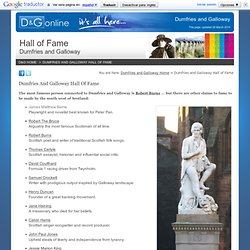
Robert The Bruce Arguably the most famous Scotsman of all time. Robert Burns Scottish poet and writer of traditional Scottish folk songs. Thomas Carlyle Scottish essayist, historian and influential social critic. David Coulthard Formula 1 racing driver from Twynholm. If you feel that we have missed someone out - send us information on that person and we will consider it for inclusion in these pages - please send an email. DISCLAIMER: Although we try to ensure that all web sites that we link to contain suitable material, the Dumfries and Galloway administrators can take no responsibility for external web site content or claims. Con la tecnología de Traductor. Old Roads of Scotland. Overview There are several mentions of Roman roads in the Accounts.
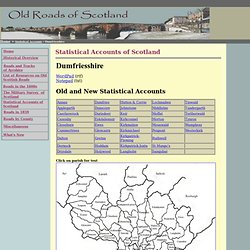
A main road ran north from Carlisle to Burnswark and then to Moffat, Crawford and beyond. A branch road led from this over to Lochmaben and Nithsdale from where it ran north past Durisdeer to rejoin the main road at Crawford. Also mentioned was a road up to the camp at Netherby and to Langholm. More unusual and unconfirmed references to Roman roads are for a road up to Castle O'er and reports that a road had been found at Overcassey in Eskdalemuir parish, a road across the Nith to Doon of Tynron and a road running through Tynron parish. In Wamphray parish there were a number of standing stones along the line of the main road north that were conjectured to be Roman milestones.
The usual remarks about roads are made. Maps > Ordnance Survey 1:10,560 - Epoch 1 > Scotland - Dumfriesshire. Gardens open in Dumfriesshire. Gardens open in Dumfriesshire - click to view ©Copyright 2012, Scotland's Gardens.

All Rights Reserved. Scotlands Gardens, 42a North Castle Street, Edinburgh, EH2 3BN, Tel: 0131 226 3714 Email: info@scotlandsgardens.org Scottish Charity number SC011337 Website Design by Darren Unwin. The Historical Families of Dunfriesshire and the Border Wars by C L Johnstone. In a previous edition, I alluded too briefly to the important Border war of the reigns of Robert Bruce and Edward I., but as the three claimants to the Scottish throne possessed lands in Dumfriesshire, who naturally took much share in it, I have added a Chapter on the subject.
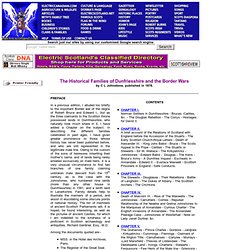
In describing the different families celebrated in past ages, I have given greater prominence to those whose history has never been published before, and who are still represented in the legitimate male line. Dumfriesshire genealogy. Description in 1887, and map showing location "DUMFRIESSHIRE, maritime Co., on S. border of Scotland; adjoins the cos. of Lanark, Peebles, and Selkirk on the N., and on the S. is washed by the Solway Firth; extends about 53 miles NW. and SE. between Ayrshire and Cumberland, and about 32 miles NE. and SW. between Roxburghshire and Kirkcudbrightshire; coast-line, about 20 miles; area, 680,217 ac., pop. 76,140, or 72 persons to each sq. mile.

Parish maps of Dumfries county in Scotlandsfamily.com - Scottish genealogy portal assisting Scottish ancestor search. Dumfries. Coordinates:

Annan, Dumfries and Galloway. Coordinates: Annan, with Mote of Annan to the right Annan River road bridge.
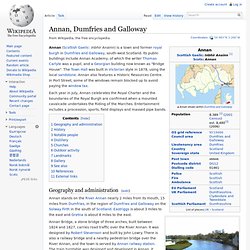
Gretna Green. Coordinates: Gretna Green is a village in the south of Scotland famous for runaway weddings.
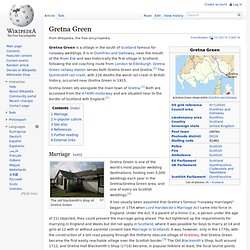
It is in Dumfries and Galloway, near the mouth of the River Esk and was historically the first village in Scotland, following the old coaching route from London to Edinburgh. Gretna Green railway station serves both Gretna Green and Gretna.[1] The Quintinshill rail crash, with 226 deaths the worst rail crash in British history, occurred near Gretna Green in 1915. Marriage[edit] Eloping. Caerlaverock Castle. Caerlaverock Castle is a moated triangular castle first built in the 13th century. Caerlaverock Castle. Drumlanrig Castle. Drumlanrig Castle entrance front Drumlanrig Castle (from Scottish Gaelic: 'druim' - ridge, and 'lanraig' - hawk) is situated on the Queensberry Estate in Dumfries and Galloway, Scotland.
The category A listed castle is the Dumfriesshire home of the Duke and Duchess of Buccleuch and Queensberry.[1] Drumlanrig Castle Construction[edit] The 'Pink Palace' of Drumlanrig,[2] constructed between 1679 and 1689 from distinctive pink sandstone,[3] is an example of late 17th century Renaissance architecture. Art collection[edit]
Ruthwell Cross. The Ruthwell Cross The Ruthwell Cross is a stone Anglo-Saxon cross probably dating from the 8th century,[1] when Ruthwell was part of the Anglo-Saxon kingdom of Northumbria; it is now in Scotland. It is both the most famous and elaborate Anglo-Saxon monumental sculpture,[2] and possibly the oldest surviving "text" of English poetry, predating any manuscripts containing Old English poetry.[3] It has been described by Nikolaus Pevsner thus; "The crosses of Bewcastle and Ruthwell ... are the greatest achievement of their date in the whole of Europe. "[4] The washing of Christ's feet, south side. Description[edit] Anglo-Saxon crosses are closely related to the contemporary Irish high crosses, and both are part of the Insular art tradition. Christ as judge, with two animals.
River Nith. For the river in southwestern Ontario, see Nith River. The River Nith (Scottish Gaelic: Abhainn Nid; Latin: Novius[3]) is a river in South West Scotland. Source, flow and mouth[edit] Nith. Devil's Beef Tub. The Devil's Beef Tub. The Devil's Beef Tub, (Marquis of Annandale's Beef-Tub, Beef-Stand, MacCleran's Loup) is a deep, dramatic hollow in the hills north of the Scottish town of Moffat. The 500-foot (150 m) deep hollow is formed by four hills, Great Hill, Peat Knowe, Annanhead Hill, and Ericstane Hill.
Devil's Beef Tub. Grey Mare's Tail. Grey Mare's Tail is a 60-metre (200 ft) hanging valley waterfall near to Moffat in southern Scotland. William Paterson (banker) Sir William Paterson. William Paterson. Kirkpatrick Macmillan. Kirkpatrick Macmillan (Born 2 September 1812 in Keir, Dumfries and Galloway; died 26 January 1878 in Keir) was a Scottish blacksmith. He is generally credited with inventing the rear-wheel driven bicycle. Invention of pedal driven bicycle? [edit] Kirkpatrick MacMillan & Bicycles. Thomas Carlyle. Thomas Carlyle (4 December 1795 – 5 February 1881) was a Scottish philosopher, satirical writer, essayist, historian and teacher.[1] Considered one of the most important social commentators of its time, he presented many lectures during his lifetime with certain acclaim in the Victorian era. Thomas Carlyle. Thomas Telford. Thomas Telford FRS, FRSE (1757–1834) was a Scottish civil engineer, architect and stonemason, and a noted road, bridge and canal builder.
Thomas Telford. Chapelcross Nuclear Power Station.